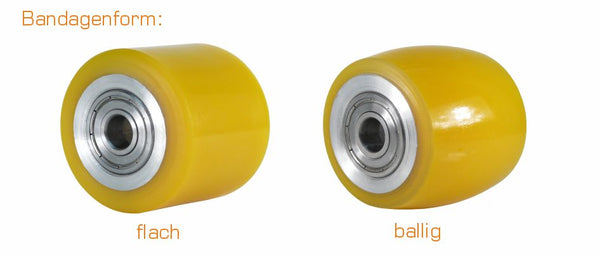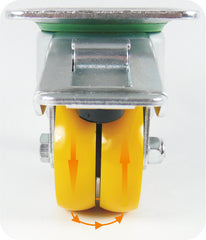Swivel resistance of swivel castors
The swivel resistance must be overcome in order to rotate one or more castors from a standing position. While driving, the swivel resistance is reduced many times over. From a stationary state, a roller that is not positioned in the desired direction of travel can mean an enormous use of force.
The swivel resistance is influenced by the following factors:
Clevis axial swivel bearing
unloading of the roll
Wheel bandage shape (convex or flat)
Single or double role
The fork head axial bearing ensures the swiveling between the mounting plate and the fork. Two axial bearings are mainly used. The pivoting resistance of this factor is therefore already reduced to the minimum.
The overhangs of all roller housings are also produced with the lowest possible swivel resistance. A roller is considered to be optimally unloaded if the quotient of overall height and overhang is between 2.50 and 4.50. Technical conditions, such as special construction heights or intentionally higher rigidity, may make it necessary to deviate from this quotient. The overhang behaves correspondingly degressively to the overall height. The resulting negative influence on the swivel resistance is decimated in these cases by the following factors.

Due to the coefficient of friction during the pivoting phase, the shape of the wheel bandage has an above-average influence on the resistance. A smaller contact area of the wheel lowers the coefficient of friction and also the swivel resistance. The contact area results from the shape of the wheel bandage. One speaks of convex and flat (Figure 3.0 bandage shape). Wheels with a flat bandage stand up with the entire wheel width. With a crowned shape, however, only in the middle area of the wheel.
Lower coefficient of friction equals lower swivel resistance.
Another factor in achieving low swivel resistance is the use of dual casters. While castors with a single wheel require a larger maneuvering space, the differential effect (Figure 3.1 double castor differential effect) sets in with double castors. Both wheels can run against each other and thus change the swivel resistance and the maneuvering range positively. Comparable to a tracked vehicle that can turn on the spot due to the counter-rotating tracks.
In addition to the low swivel resistance, double castors bring extraordinary advantages, especially when castors are mounted very close to each other.

